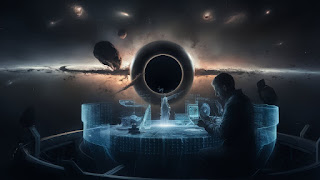Studying Black Holes

Studying black holes is one of the most intriguing and challenging endeavors in modern astrophysics. These enigmatic cosmic objects, characterized by their immense gravitational pull and ability to trap even light itself, defy conventional understanding and offer a window into the extreme physics of the universe. Through a combination of theoretical modeling, observational techniques, and technological advancements, scientists have made significant strides in unraveling the mysteries of black holes, shedding light on their formation, properties, and role in shaping the cosmos.
At the heart of studying black holes lies the theoretical framework of Einstein's general theory of relativity, which describes how gravity warps the fabric of spacetime. According to general relativity, black holes are formed when massive stars collapse under their own gravity at the end of their life cycles, creating regions of spacetime so densely curved that not even light can escape. These invisible behemoths, known as singularities, are surrounded by an event horizon, a boundary beyond which nothing can escape the black hole's gravitational grip.

One of the primary goals of studying black holes is to observe their effects on the surrounding environment and infer their properties indirectly. By observing the behavior of stars, gas, and dust in the vicinity of black holes, astronomers can deduce the presence of these invisible objects and estimate their masses, spins, and accretion rates. Techniques such as spectroscopy, which analyzes the light emitted by matter falling into black holes, and astrometry, which measures the motion of stars around black holes, provide valuable insights into their dynamics and characteristics.
In recent years, technological advancements in observational techniques have enabled scientists to study black holes with unprecedented clarity and precision. Ground-based observatories such as the Event Horizon Telescope (EHT) and space-based telescopes like NASA's Chandra X-ray Observatory and the European Space Agency's XMM-Newton have captured detailed images and spectra of black hole systems, revealing the intricate structures of their accretion disks, jets, and surrounding environments. These observations have provided compelling evidence for the existence of black holes and offered insights into their behavior and evolution.
One of the most groundbreaking discoveries in the study of black holes is the detection of gravitational waves, ripples in spacetime caused by the motion of massive objects such as merging black holes. In 2015, the Laser Interferometer Gravitational-Wave Observatory (LIGO) made history by detecting gravitational waves for the first time, originating from the merger of two black holes located over a billion light-years away. Since then, LIGO and its international partners have detected dozens of gravitational wave events, providing unprecedented insights into the dynamics of black hole mergers and the nature of gravity itself.
Moreover, studying black holes offers valuable insights into a wide range of astrophysical phenomena, including galaxy formation and evolution. Supermassive black holes, which reside at the centers of most galaxies, play a crucial role in regulating the growth and activity of their host galaxies through processes such as accretion, feedback, and galaxy mergers. By studying the properties and distribution of black holes in galaxies of different sizes and environments, scientists can gain insights into the coevolution of galaxies and their central black holes over cosmic time.
Furthermore, studying black holes has profound implications for our understanding of fundamental physics and the nature of spacetime. Black holes represent extreme environments where the effects of gravity, quantum mechanics, and thermodynamics converge, offering unique opportunities to test the predictions of general relativity and explore the boundaries of our current understanding of the universe. By studying the behavior of matter and energy in the vicinity of black holes, scientists can probe the nature of spacetime at its most extreme limits and search for clues about the ultimate fate of the cosmos.

In conclusion, studying black holes is a multifaceted and interdisciplinary endeavor that spans theoretical modeling, observational astronomy, and technological innovation. By unraveling the mysteries of these enigmatic cosmic objects, scientists can gain insights into the nature of gravity, the dynamics of the universe, and the fundamental laws of physics. As our knowledge of black holes continues to grow, so too will our understanding of the universe and our place within it, opening new windows into the depths of spacetime and the mysteries of the cosmos.




0 Comments